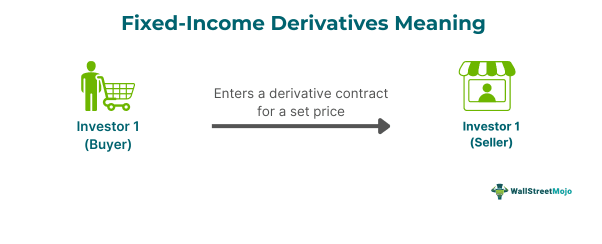Table of Contents
What Are Fixed Income Derivatives?
Fixed income derivatives are agreements between two parties to trade (buy or sell) a fixed income instrument on a specific date in the future but on a preset price already decided between the counterparties in the contract. The derivative helps in hedging the risk by speculating the price and locking it for a future delivery.

The gain and loss of such derivatives are derived from bonds, interest rates, and other bond market variables. They can be traded on stock exchanges and over the counter (OTC). In this agreement, the buyer expects the price to increase, whereas the seller anticipates that the price will decline due to the predetermined value.
Key Takeaways
- Fixed income derivatives are contracts to transit a fixed income instrument at a preset price on a fixed future date.
- The agreement allows hedging risk based on the counterparties' speculation in a futures contract.
- Such fixed income derivative products can be swaps, futures, or forward contracts, but the latter are customizable and standardized.
- The central idea of such instruments is to bet on a future price while locking in a preset price today, anticipating to profit from the difference based on zero-sum games.
Fixed Income Derivatives Explained
Fixed-income derivatives are associated with fixed-income instruments that work like investments, providing periodic incomes at regular intervals with reasonable returns. The most important aspect is that investors use contracts to lock in a particular preset price today, claiming ownership of the bond in the future. As the price is locked in, the parties are obligated to trade at it only, which, depending on the market shift, favors either the derivative seller or buyer.
In fixed income derivatives trading, the profit depends on the side the investor is representing. A buyer enters the contract expecting the market price will go up in the future. Conversely, a seller believes that the bond's price will decline in the future, and both are looking forward to obtaining the difference between the set price and the future price as profit. All the derivatives get traded on the exchanges, but forward contracts are traded over the counter.
Among all fixed income derivatives products, forward contracts attract most of the investors looking to hedge all bond market risks, including interest rates. The whole concept, in a nutshell, lies in betting on a future price by locking in a preset value today; if the spot price is above it, it's the buyer's profit. On the other hand, if the price declines, it is the seller's gain. The price of the underlying instrument in the market is affected by three main factors: inflation, bond rating, and interest rates. Inflation impacts purchasing power and returns, but the bond rating issued by credit agencies affects its market creditworthiness, which eventually leads to price movement.
Types
There are different types of these derivatives:
#1 - Interest Rate Derivatives
The payments of such derivatives are based on the interest rate or the underlying interest-bearing asset fluctuations, such as inflation swaps, forward rate agreements, futures, options, etc. Such derivatives are mainly used by banks, big companies, institutional investors, and other financial institutions as hedges.
#2 - Credit Derivatives
Such instruments allow investors to reduce their exposure to credit risk. They are traded over the counter and allow creditors to shift the total or partial default risk of a borrower to a third party who typically accepts the risk in exchange for a premium. The most common credit derivatives are - credit default swaps (CDS), total return swaps, credit spread options, collateralized debt obligations (CDO), etc.
Examples
The two examples are as follows:
Example #1
The core idea of fixed income derivatives trading is based on speculation of future prices and taking advantage of a derivative instrument by locking a set price for future delivery. Suppose William and Jason are two investors with opposite mindsets and beliefs. William speculates that a particular bond's rating will increase in the future, and Jason believes the opposite.
They enter into a fixed-income forward contract with a preset value and lock in the delivery price today. At the time of delivery, William's speculation proves correct; he buys the bond for a lower price than its market value or spot price. It is a simple fixed-income derivative, but many direct and indirect factors must be considered in real-world trading.
Example #2
For the second example, suppose Denver, a derivatives trader, is looking to hedge interest rate risks and believes that interest rates will decline in the future. Therefore, he enters into a fixed-income derivative contract as a seller, locking in a preset price for future delivery.
Now, as anticipated by Denver, the interest rates drop by the time of delivery. Hence, Denver is able to hedge the risk because he is able to sell the bond at the predetermined price already decided at the time of the contract, making a profit. In the first example, it was a buyer's perspective trying to speculate, but in the second example, it is the seller's point of view hedging the risk of bond market variables.
Fixed Income Derivatives vs Equity Derivatives
The significant differences between fixed income and equity derivatives are:
| Fixed Income Derivatives | Equity Derivatives |
|---|---|
| It consists of bonds and debt securities. | Equity derivatives are based on stocks. |
| These are debt securities, generally of different types, such as municipal, corporate, and government bonds. | A stock option is an equity derivative, and its value is based on the underlying stock price movement. |
| They are relatively less risky and backed by government funds. | These are riskier. |
